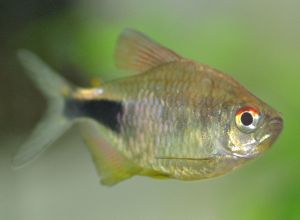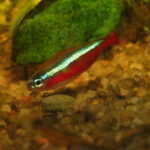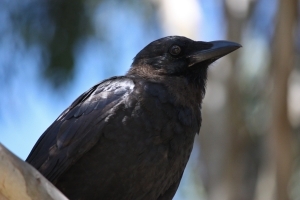Emperor Tetra Fact Sheet
The Emperor Tetra, Nematobrycon palmeri, is a beautiful fish. It is one of the larger Tetras, growing to about 8 cm as a maximum, although one this large is unusual. It comes from streams and rivers of western Colombia including The Rio Atrata and The Rio San Juan. This is a tropical area, and the EmperorTetra is a tropical fish. I suggest heating them with a standard aquarium heater with the thermostat set at 24̊ C.
I have searched for information about this fish, and have found it even more contradictory than usual. Therefore the information in this fact sheet is based mainly on my own experience in keeping and breeding The EmperorTetra.
Feeding and Keeping
The Emperor Tetra is an omnivore, eating both animal and vegetable food. Any good flake or pelleted fish food is a good basis for its diet. They will benefit from live food like Daphnia and wrigglers (Mosquito larvae) as well as frozen fish food.
The Emperor Tetra is a fairly easily kept fish which is a little less fussy about its water conditions than many tetras. It does not school as readily as most tetras, and a single fish, or a pair appears happier than with most tetras. The males and females are easily told apart. There are many differences,but I find the easiest one to be sure of is the tail. The male has a three pronged tail with the centre,black, part extending beyond the rest of the tail while in the female, the centre black part only reaches as far as the clear part of the tail.
They can be kept happily in most mains water as long as you get rid of the Chlorine or Chloramine, and adjust the pH to about seven. Although coming naturally from water which is soft and acid they will adjust to most types of water
Companions
Suitable companions for The Emperor Tetra include the other tetras, including Neon Tetras , Cardinal Tetra , Glass Bloodfin Tetras, Black Widow Tetras , Head and Tail Light Tetras etc. As well as the other tetras, The Emperor Tetra can be kept with White Cloud Mountain Minnows, Zebra Danios , small gouramis, Corydoras catfish including the Peppered Catfish, Guppies,Endlers Guppies, small barbs and other small, not too aggressive fish.
Breeding
I have found them easy to breed. However, some people consider them a difficult fish, and I would caution that I am only writing about small scale breeding for interest, not about large scale commercial breeding.
I suggest this set up for breeding. Use an aquarium of at least ten gallons or fifty litres capacity. Plant it heavily so there are many dark hiding places. Put a good sized pair of Emperor Tetras in and feed them well. Daphnia is an excellent food. This can be supplemented with any good dry fish food and with frozen food like blood worms.
With reasonable luck the fish will spawn and some of the babies will survive. In my experience, the parents are not cannibalistic. The babies will find some useful natural food in the form of protozoa, algae, etc. Screened Daphnia will provide them with more nourishment as they grow, and dry fry food food, ‘Fry Bites’ can be used.
Cost
One disadvantage of this beautiful fish is its cost. As of January 2011; A Neon Tetra costs $1, a Glassblood Fin Tetra costs $4 and an Emperor Tetra costs $5. On the other hand most tetras need to be in a school to look good and seem happy while a single pair of Emperors looks good.
Sources
Emperor Tetras





